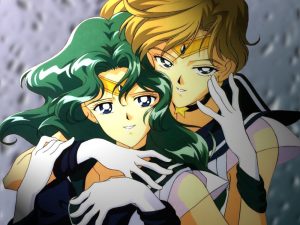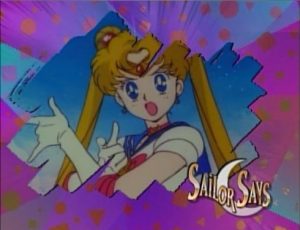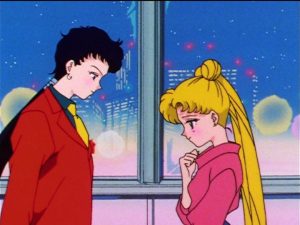 Teen Vogue recently published an article titled, “Sailor Moon’s” Erasure of LGBTQ Characters, but the author misses a lot of key points. It’s great to see Sailor Moon mentioned in a mainstream magazine, but it is highly disappointing that the author failed to do any research. Yes, Gabe Bergado is correct that television executives were not prepared to introduce gay and lesbian characters to young American audiences, but at the time (1995, the author wrongly states 2000) television executives weren’t even sure a Japanese show would work in the US English market. To understand how the author gets everything wrong in the article, we need to take a trip back in time.
Teen Vogue recently published an article titled, “Sailor Moon’s” Erasure of LGBTQ Characters, but the author misses a lot of key points. It’s great to see Sailor Moon mentioned in a mainstream magazine, but it is highly disappointing that the author failed to do any research. Yes, Gabe Bergado is correct that television executives were not prepared to introduce gay and lesbian characters to young American audiences, but at the time (1995, the author wrongly states 2000) television executives weren’t even sure a Japanese show would work in the US English market. To understand how the author gets everything wrong in the article, we need to take a trip back in time.
Sailor Moon started its life in Japan as Code Name Sailor V, a two volume series with characters who loosely represented the developed senshi we have grown to love. In this short series, Sailor Venus was the protagonist. She was the star of the show – there were no other sailor soldiers backing her up and she wasn’t part of a team. There were no lesbians, no gays, no nothing. Just Sailor V and a few characters to keep the story going for two short volumes. When the idea was pitched to turn Code Name Sailor V into a show, Naoko Takeuchi went back to the drawing board to create a series about a group of space girls with magical powers. Sailor Venus was integrated into the team and the series became something much more fleshed out. Takeuchi intended for this new series to last only one season; however, due to immense popularity, she was pressured to create more story arcs. What does this mean? It means Sailor Moon as we know it wasn’t supposed to exist. Sailor Moon wasn’t even supposed to be a cutesy magical girl shojo series – Takeuchi originally envisioned killing the protagonists off but was told she couldn’t.
In the original Japanese anime and manga, we are treated to a variety of characters with different personalities, sexual preferences, and lifestyle choices. Bergado’s assessment of the erasure of lesbian sexuality is flat out incorrect. Yes, their lesbian relationship was erased, and that is the basis of the Teen Vogue article since the author intentionally glosses over the removal of the gay relationship between Kunzite and Zoisite. Only briefly does this issue get mentioned, when quite frankly, if we are talking about the erasure of identity, we should start from the beginning with season one and make our way to the final season where things get really weird. Of course, based on the information provided in the article, I question if the author has even seen every episode of Sailor Moon or read the manga. Maybe he has, but I’m not seeing it in his piece. But now, I am digressing. Let’s start eviscerating the argument.
When DiC won the English rights to Sailor Moon, they were taking a huge chance. Most Americans didn’t know what anime or manga were at the time. You couldn’t just walk into a bookstore and buy manga. You really had to look for it in specialty shops. DiC needed this show to do well, because they were paying money for the license and had to get that money back, so, naturally they did what they could to make the show as vanilla and censored as possible, including omitting several episodes while chopping up and combining several others from the first 62 episodes. This practice still exists today in other countries where licensees are concerned their audiences will not accept the original material unedited.
The Teen Vogue writer jumps ahead, ignoring the failure of the DiC translation and jumps to the third season, which might be when he first started watching Sailor Moon. That, or the erasure of the Michiru and Haruka’s sexuality suiting a feminist, lesbian agenda against the ‘establishment’ is more important than being outraged at the erasure of the gay relationship in season one or the erasure of Japanese culture throughout the entire first two seasons. Or the erasure of the female body throughout the original dub (bust lines were modified throughout the transformation sequences to hide the feminine shape of the scouts).
The author just wants to harp on season 3 while ignoring everything else that ruined the original dub:
…Erasing the love between Sailor Uranus and Neptune is just egregious and definitely is a testament to where we were as a culture back in 2000…. executives were worried about having these lesbian characters be in an animated show for television.

You can’t complain about the erasure of lesbians and gays from Sailor Moon while ignoring that Usagi became Serena, Mamoru became Darien, and so on and so forth. Even Usagi’s best friend, whom Bergado would know best as “Molly” is a testament to the censorship run amok in the DiC dubs. American audiences were duped into thinking Usagi’s brown haired friend was a cute girl next door from Brooklyn, with a terribly thick, New York accent that makes zero sense in the middle of Tokyo, Japan. Additionally, DiC made every effort possible to remove kanji from the series and replaced signs originally written in Japanese. But let’s step back for a moment and take a break from pointing out the ethnocentrism, sexism, racism, and homophobia that can be extrapolated from the treatment of the first two seasons and recall that we didn’t yet have a TV rating system for shows.
Censorship was a real thing in 1995 and the only gay animated character we knew was Smithers, and even then, as a child, did you really know for sure that he was gay? The Simpsons pushed the envelope with a lot of issues, but they definitely took a subtle approach to writing in their gay character. Sailor Moon wasn’t subtle with anything, therefore, without a rating system in place, American executives really had to find a way to promote an alien show without it getting censored off the air before anyone had the chance to figure out what anime was. By 2000, we had a ratings system, therefore, the Cartoon Network adaptation had fewer changes, although yes, we did lose the romantic lesbian relationship to ‘cousins’ out of fear Sailor Moon would still get censored, because in 2000, anime still wasn’t a big thing in the United States and even in reality, lesbians and gays didn’t enjoy a lot of the rights they now have in 2017.
I get that the author is hurt that there was no opportunity to relate to lesbian or gay characters in Sailor Moon as a child 
What I don’t quite understand, is, with everything that was erased in Sailor Moon, why is the erasure of the lesbian relationship the most significant to this author? Especially during a time when Sailor Moon is finally getting a true translation that liberates it from the horrible dub we all grew up with. Is it not important that the Japanese music was removed? The kanji was literally erased, and the Japanese names were replaced with English names that often made no sense? What about the plot? Whole chunks of story were removed, death scenes taken out, and even friendly violence (Usagi often gets slapped out of her silly ideas by Rei) was omitted. Of course, this is another layer of a fat onion that needs to be peeled because the anime didn’t even follow the manga. To Naoko Takeuchi, the anime represented a male perspective that wasn’t found in her manga. Why are you not outraged by that!?
Now that we’ve spent a great amount of time exploring the original, terrible dub, I’d like to ask the author of the Teen Vogue magazine why there is no mention of the new license through Viz Media or a new series, Sailor Moon Crystal, which follows the manga more accurately? Is it because Teen Vogue is looking for something to fill their feminism hashtag? Is the author looking to jump on the band wagon and pick a show from 1995 to be the subject of a leftist, uninformed agenda? Sailor Moon and a handful of other shows helped the barrier for Japanese animation in the United States. After all these years, the series is finally getting a well deserved, accurate translation with a new script and a new cast.
Fans across the country have been rejoicing for some time as Viz Media rolls out a wonderful new English dub for longtime fans of the series. So yes, you can see the romance between Neptune and Uranus in full bloom, in English, anytime you want. You can also see a new, animated series that more closely follows what Naoko Takeuchi envisioned when she drew Sailor Moon. Unfortunately, the author doesn’t take time to acknowledge that efforts are being made to deliver a 100% true to translation Sailor Moon and that’s what pisses me off the most. Thanks to a shitty, censored dub of Sailor Moon, you’ve now got access to a whole genre of gay and lesbian manga and anime from Japan. It’s 2017. Get with the program.


